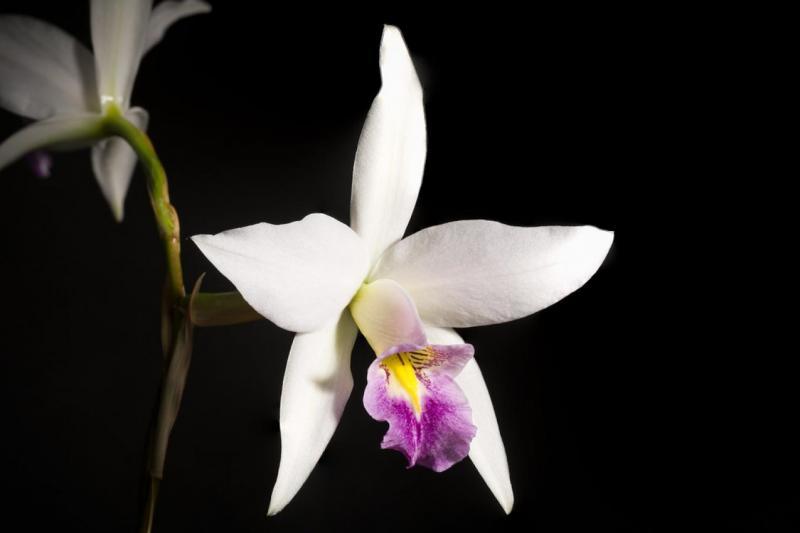Laelia anceps
Also known as: Two or Laelia anceps h.v. sierrae Laelia anceps h.f. flammea Laelia anceps h.v. ashwortiana Laelia anceps h.f. delicata Laelia anceps h.v. ileana Laelia anceps h.v. oxacauca Laelia anceps h.f. chamberlainiana Laelia anceps h.v. dawsonii-chilapensis Laelia anceps h.f. concolor Laelia anceps ssp. dawsonii h.f. chilapensis Laelia anceps h.f. semialba Laelia anceps ssp. oaxaqueña Laelia anceps h.f. disciplinata Laelia anceps h.v. bulls Laelia anceps h.f. albescens Schomburgkia dawsonii Laelia anceps h.f. sanderiana Schomburgkia mottae Laelia anceps h.f. rosea Laelia anceps ssp. anceps h.f. alba Laelia anceps h.v. caxacoha Laelia mottae Laelia anceps var. superba Laelia anceps var. oweniana Laelia anceps h.f. veitchiana Laelia anceps var. munda Laelia anceps var. obscura Laelia schroederae Laelia anceps var. waddoniensis Laelia anceps var. virginalis Laelia anceps var. schroederiana Laelia anceps var. morada Laelia anceps var. radians Laelia anceps var. sanderiana Laelia anceps var. simondsii Laelia anceps var. roeblingeana Laelia anceps var. protheroana Laelia anceps var. hollydayana Laelia anceps var. rosefieldiensis Laelia anceps ssp. hollydayana Laelia anceps var. amesiana Laelia anceps var. ashworthiana Laelia anceps var. crawshayana Laelia anceps f. alba Laelia anceps var. holocheila Laelia anceps var. leucosticta Laelia anceps var. kienastiana Laelia anceps var. blanda Cattleya anceps h.v. veitchiana Laelia anceps var. scottiana Laelia anceps var. williamsii Laelia anceps h.f. guerrero Laelia anceps ssp. anceps Laelia anceps ssp. dawsonii Laelia anceps h.v. williamsiana Laelia anceps barkeriana Laelia anceps var. stella Laelia anceps h.f. roeblingiana Laelia anceps ssp. dawsonii h.v. chilapensis Laelia anceps ssp. Oaxaquena Laelia anceps var. Ballantineana Laelia anceps var. Barkeriana Laelia anceps var. percivaliana Laelia anceps var. Hyeana Laelia anceps h.v. Hillii Laelia anceps var. Hilliana Laelia anceps var. grandiflora Laelia anceps var. delicata Laelia anceps h.v. dawsoni Laelia anceps h.f. lineata Bletia anceps var. barkeriana Laelia dawsonii Laelia anceps h.v. roeblingiana Laelia barkeriana Laelia anceps var. vestalis Laelia anceps h.v. veitchiana Laelia anceps h.v. guerrero Laelia anceps var. dawsonii Laelia anceps var. alba Laelia anceps var. lineata Laelia anceps h.f. coerulea Laelia anceps var. chamberlainiana Laelia anceps ssp. sanderiana Laelia anceps f. chilapensis Laelia hallidayana Laelia sanderiana Laelia schroederiana Laelia anceps ssp. schroederiana in the subfamily: Epidendroideae
Native to: Chiapas - Mexico Guatemala Guerrero - Mexico Honduras Oaxaca - Mexico Puebla - Mexico Querétaro - Mexico Tamaulipas - Mexico Veracruz - Mexico
General Information
Two is a sympodial cool to warm growing epiphytic orchid belonging to the sub family Epidendroideae native to Mexico, Guatemala and Honduras.
Plant Description
Sympodial. Grows to 30-35cm. Each new growth has a single leathery rigid, elliptic leaf that grows to 20-25cm long. Pseudobulbs grow to 3-10cm
Flowers
Numerous fragrant blossoms appear during Winter
Fragrance
The orchid is fragrant.
Blooming Season
- Winter
Substrate(s)
- Coarse
- Bark
Care Notes
This orchid goes into a dormancy phase during winter, during this phase it is best not to provide water unless the plant is starting to look thirsty. The lack of water increases the chance of flowering in spring, and also reduces the likelihood of any rot forming. Do not resume watering until new growth has appeared and is growing strongly.
Often a period of intense growth occurs after dormancy. During this time the amount of light, water and fertiliser the plant receives will directly impact the amount of growth that occurs during this time, and in the case of seedlings, will reduce the time required to reach maturity.
It's recommended to heavily reduce the water amount at the middle to end of autumn to trigger dormancy. Leaves on older bulbs will begin to drop during this time while the newer bulbs continue to mature until terminal leaves appear at the tip of the pseudobulbs.
Repotting can be done any time of the year though it's best to do it in early spring when new growth is appearing as this also means new roots will appear to help the plant anchor into the new media and offset any damage to established roots during the repotting process.
Fragrant:
- IsFragrant
Climate
The orchids are well adapted for hot weather, accompanied by sporadic, unpredictable rainfall and a generally dry climate. They can tolerate a lot of neglect as they are quite used to it, however they can be prone to underwatering and may collapse in cold, wet weather.
For this reason it's best to dedicate a sheltered, protected area for them where the watering can be controlled, such as a corner of a greenhouse or in a sheltered balcony. They can also do well hung near the roof of a shadehouse or sheltered greenhouse where they receive the extra heat but not as much water as other plants.
Grows at high elevations. Rainfall ranges from 24mm to 162mm per day, heaviest in June and lightest in January. Temperature ranges from 10C to 27C, highest in May (17C to 27C) and lowest in January (10C to 19C).Fertiliser
dormant-medium-demand-orchid Use balanced fertiliser during Summer. Be sure to flush out excess fertiliser by running water through the media regularly year round. Apply fertiliser regularly at half strength year round. Use a high Nitrogen fertiliser during Spring and Summer. Use a low Nitrogen fertiliser during Summer. Use a high Phosphorous fertiliser during Summer.
Potting
These plants are quite forgiving and will do well repotted ever 2-3 years. The mix should be coarse, well draining, and allow space for air to move and for roots to grow.
Alternatively, these plants will also do well mounted to tree fern or cork slabs, or mounted to trees.
Best time for repotting or mounting the orchids is the end of winter when new growths start to appear. Avoid repotting during hot weather,
Repotting is best done annually.





















